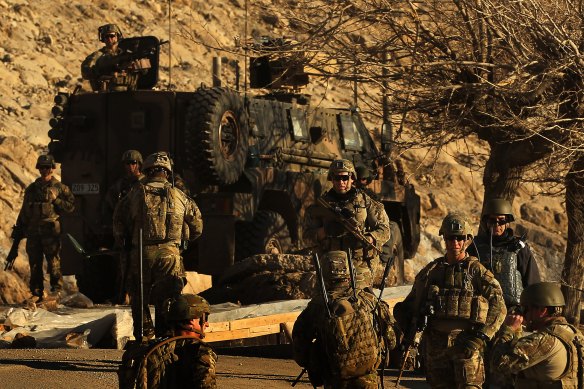This was published 3 years ago
Little to show for allied involvement in Afghanistan
By Amin Saikal
In an op-ed in Herald of 1 June 2011, following the US killing of Osama bin Laden a month earlier, I warned, “Australia cannot expect its human sacrifices and material investment to make much of a difference” in Afghanistan, intimating that hopefully we would not see the day when Australian leaders looked back and wondered “what was that all about?”
That day has arrived with President Joe Biden’s announcement to end America’s two-decade long military intervention in Afghanistan by the 20th anniversary of 9/11, and Prime Minister Scott Morrison’s decision to follow suit.

Australian soldiers on patrol in Oruzgan. Credit: Kate Geraghty
Australia has been a participant in the Afghan venture from its beginnings. In addition to providing reconstruction aid, it has played an active role in the US-led military intervention to bring, as put by former President George W. Bush in late 2001, peace, stability, prosperity and security to the country.
The province of Oruzgan – a relatively small area in the Taliban-led insurgency hotbed in southern Afghanistan – came to be the main focus of the Australian military and civilian operations, especially between 2010 and 2014.
The Diggers performed well in stabilising and rebuilding the province. They gained a reputation for improving the living conditions for many in the province, despite recent revelations of alleged war crimes by some of them.
Yet it has come at a cost, with 41 Australian soldiers killed, 261 wounded, some of them crippled for life, and thousands more sustaining post-traumatic stress disorder, leading several of their returnees to commit suicide. The combat mission has consumed some 80 per cent of Australia’s estimated $10 billion expenditure in Afghanistan.
President Barack Obama’s decision in late 2009 to strengthen the Afghan security forces to fight the insurgents and to bring home most of the American troops by the close of 2014, enabled Australia to do the same by ending its deployment in Oruzgan. It handed over the security of the province to a notorious anti-Taliban warlord ally, Mutiullah Khan – an illiterate, polarising figure, accused of extortion, brutality and highway robbery. Australia funded him and trained his fighters, including some in Australia.
However, the Taliban’s assassination of Mutiullah Khan in March 2015 left a big hole in Australia’s approach and opened Oruzgan to the Taliban. Today most of the province is in the hands of the militia and all Australia’s good work lies in tatters.
Afghanistan’s security situation as a whole has deteriorated since then, more dramatically in the past year since the US signed a peace agreement with its erstwhile terrorist enemy, the Taliban, in February 2020.

Newly graduated Afghan National Army soldiers march at their graduation ceremony.Credit: AP
The deal was badly flawed. It essentially provided for the withdrawal of all foreign forces from Afghanistan by May 1, 2021 in return for a pledge by the Taliban not to allow any hostile actions against the US and its allies from Afghanistan, in spite of the militia’s limited territorial control. It made the Taliban America’s partner in peace, without committing them to a universal ceasefire, let alone to a lasting political settlement with the Afghan government and other parties in the socially and culturally divided and mostly impoverished mosaic Afghanistan. The Afghan security forces have so far managed to prevent the Taliban from taking over any major city, but they have done so with support from the limited US and allied troops and American air power.
Biden’s termination of America’s entanglement in the longest war in its history, which Australia and other allies will follow, amounts to a clear admission of defeat. The Taliban, while rejecting Biden’s new troop exit deadline, have already claimed victory. They have never had it so good.
Washington will maintain a small, robust residual force to protect its and allied missions in Kabul and to conduct counter-terrorism operations. But how small? Currently, there are only 2500 American and 7000 allied troops – far less than what the US has in Germany, Italy or Spain.
Afghanistan faces another tough survival test in its largely turbulent modern history.
It has also assured continued US non-military support to the weak and kleptocratic Afghan government. But this will do little to calm the nerves in Kabul, and amongst a majority of the Afghan people, who are opposed to the return of the Taliban’s extreme theocratic rule and do not want to lose the gains made, especially in terms of women’s rights, infrastructural development and social freedoms.
With no viable political settlement in place, and no certainty that the US-proposed international conference in Turkey next month might produce a peace deal that could be implemented on the ground, Afghanistan faces another tough survival test in its largely turbulent modern history. It could once again descend into an internecine conflict, with Pakistan as the main backer of the Taliban and Afghanistan’s other neighbours backing different warring groups for their conflicting regional interests.
The suffering Afghan people have reason to feel duped by their leaders and interventionists. It is also time for the US and its allies to ponder what they have achieved in return for their hefty investment in money and blood. If the purpose was to disable the Taliban and their ties with Al Qaeda and help generate a new stable Afghanistan, they have failed.
Amin Saikal is Adjunct Professor of Social Sciences at University of Western Australia, and author of Modern Afghanistan: A History of Struggle and Survival (2012)